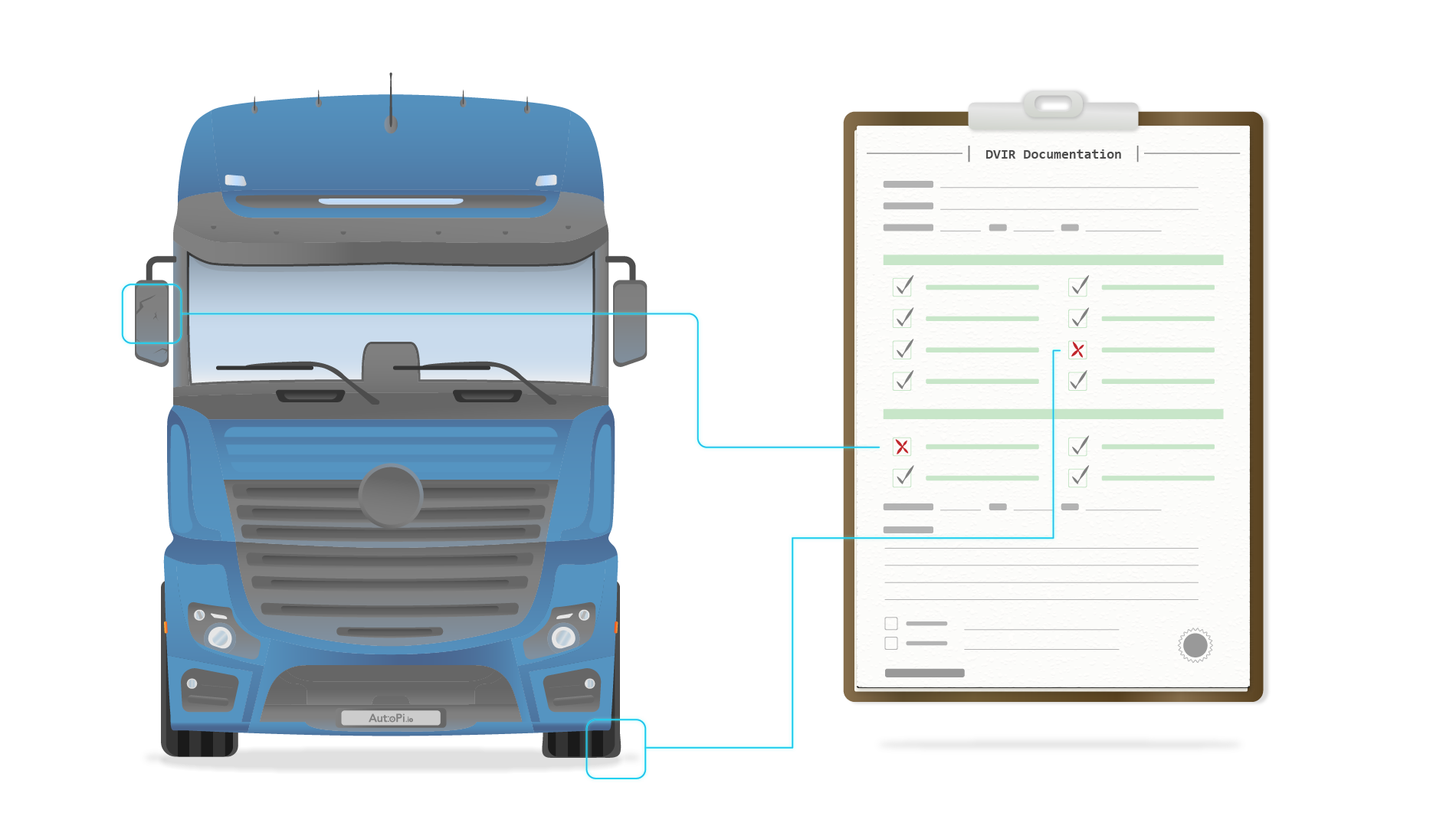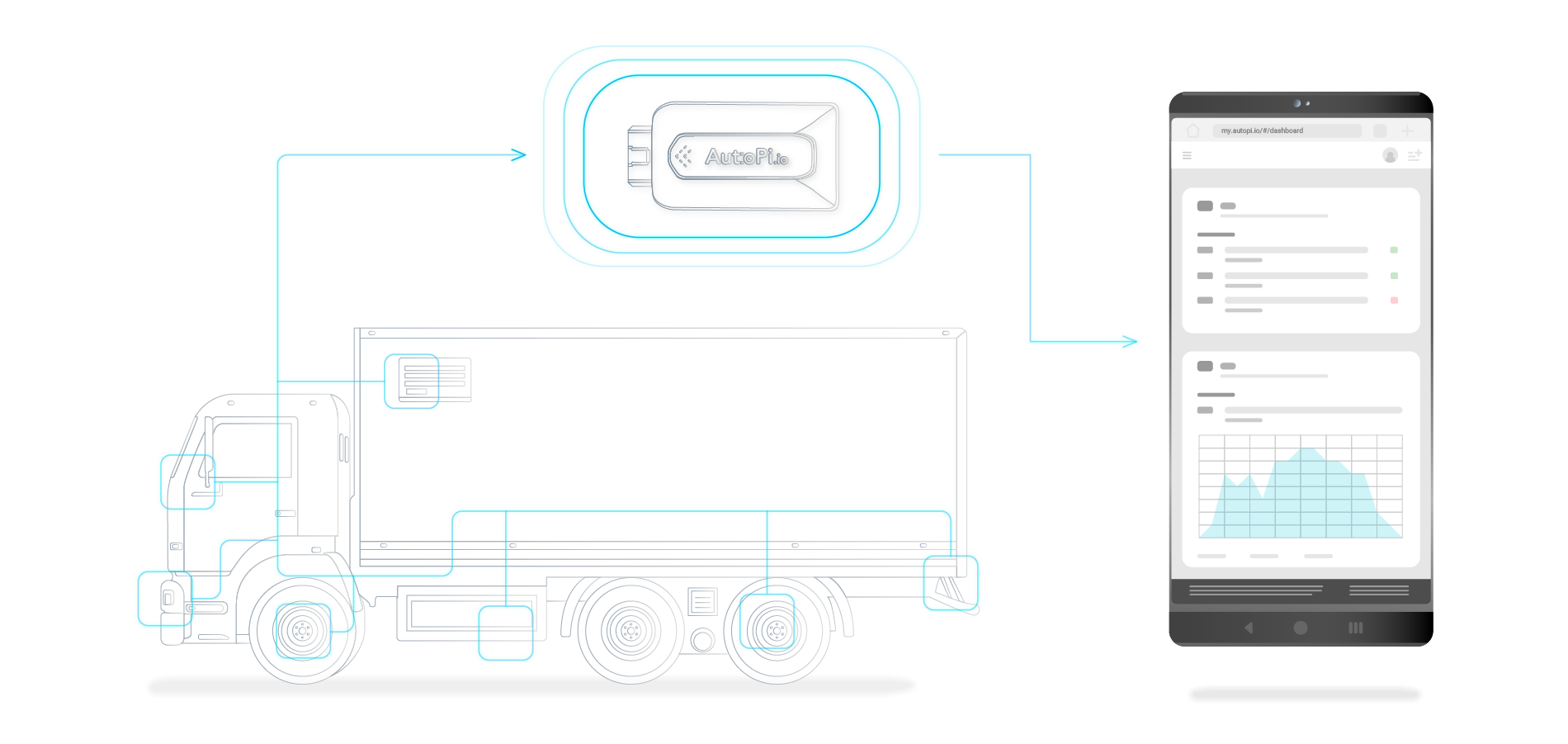In both commercial trucking and public transportation, the Driver Vehicle Inspection Report (DVIR) is not just a form—it's a critical safeguard for road safety.
This guide unpacks the essentials of DVIR, highlighting compliance risks and potential penalties. Whether you’re a commercial trucking fleet manager or a public transportation driver, here’s your concise roadmap to stay informed and penalty-free. Let’s get started.
What is DVIR?
DVIR, standing for Driver Vehicle Inspection Report, is a daily mandatory process for commercial truck drivers and those in public transportation. Before taking a vehicle on the road, DVIRs serve as the driver’s verification that their vehicle is safe and operational. This isn't just a formality, it's a federal law and an integral aspect of road safety.
Fleet vehicles are subject to stringent regulations, notably those imposed by the Federal Motor Carrier Safety Administration (FMCSA). These regulations mandate drivers to conduct both pre-trip and post-trip vehicle inspections. Each of these inspections involves a thorough review of specific vehicle parts and accessories, such as the brakes, steering mechanism, tires, lights, and other critical components that ensure safe operation.

The DVIR is a streamlined, standardized document that contains a checklist of components. If a driver identifies any faults or issues during this inspection, it is mandatory for them to record these on the DVIR form and promptly notify their supervisor. For significant faults that may jeopardize the safe operation of the vehicle, the vehicle must be withdrawn from operation until the necessary repairs are completed and verified.
This process isn't an administrative burden but a proactive safety measure. By conducting regular vehicle checks as stipulated in the DVIR, a driver plays a critical role in spotting potential faults before they escalate into serious safety issues.
In essence, DVIR is not merely a report, it is a commitment to safety, compliance, and professional responsibility on the part of each driver.
The Crucial Role of DVIRs
Federal regulations dictate that drivers must complete these inspection reports under the guidelines set by the Federal Motor Carrier Safety Administration (FMCSA). The intent? To enhance the safety of both the driver and other road users. This systematic check helps drivers identify potential vehicle defects early, which are then required to be reported to the motor carrier.
How does a typical DVIR inspection look like?
During a DVIR inspection, the driver meticulously examines crucial vehicle components, such as brakes, steering, and lighting, using a comprehensive vehicle inspection checklist. This thorough inspection must occur pre- and post-trip.
If a driver identifies a defect impacting the vehicle's safe operation, they must immediately report it to their motor carrier or intermodal equipment provider. Repairs must then be actioned before the vehicle is deemed safe and compliant under DVIR regulations.
| [x] Step in DVIR Process | [y] Vehicle Component | [z] Action Required | [a] Responsible Party |
|---|---|---|---|
| Pre-Trip Inspection | Brakes | Examine for wear and functionality | Driver |
| Pre-Trip Inspection | Steering | Check for responsiveness and alignment | Driver |
| Pre-Trip Inspection | Lighting | Verify all lights are operational | Driver |
| Post-Trip Inspection | Brakes | Re-examine for any changes or wear | Driver |
| Post-Trip Inspection | Steering | Re-check for issues | Driver |
| Post-Trip Inspection | Lighting | Ensure all lights remain operational | Driver |
| Defect Identification | Any critical component | Report defects | Driver |
| Defect Reporting | N/A | Notify motor carrier or intermodal equipment provider of defects | Driver |
| Repair Action | Defective Component | Conduct necessary repairs | Motor Carrier or Intermodal Equipment Provider |
| Compliance Verification | Entire Vehicle | Confirm repairs and deem vehicle safe | Motor Carrier or Intermodal Equipment Provider |
This table succinctly outlines the step-by-step process of a typical DVIR inspection, detailing the specific vehicle components that need checking, the actions required at each step, and the parties responsible for these actions. Regular adherence to this process is not just a regulatory requirement—it is a proactive stance towards ensuring road safety for all.
What are DVIRs Requirements?
DVIR (Driver Vehicle Inspection Report) is a federally mandated process that ensures commercial motor vehicles are in safe and operational condition before hitting the road. It is not just a formality; it is a critical aspect of road safety and compliance.
Key Requirements

-
Daily Inspection: Drivers are required to conduct both pre-trip and post-trip inspections daily.
-
Inspection Items: The FMCSA mandates that drivers inspect specific parts and accessories of their vehicles before and after every trip. This includes brakes, steering, tires, lighting, coupling devices, and emergency equipment.
-
Record Keeping: Following the inspection, drivers must complete a DVIR form, indicating any faults or deficiencies detected. This must be signed and dated by the driver, even if no faults are found.
-
Reporting Faults: If defects are discovered during the inspection, they must be reported to the driver’s motor carrier or designated agent. The carrier or agent must acknowledge receipt, sign, and date the DVIR, and initiate the necessary corrective actions.
-
Retention of DVIRs: Federal law stipulates that motor carriers must retain these inspection reports for at least three months after the inspection date. Drivers are also required to keep a copy for a minimum of six months.
Are there penalties for non-compliance?
Non-compliance with DVIR regulations, as specified in 49 CFR, exposes both drivers and motor carriers to stringent penalties from the Department of Transportation (DOT). Consequences of non-compliance include:
Fines and monetary penalties
The vehicle being deemed Out of Service (OOS) until all repairs are complete
Potential negative impact on the carrier’s Compliance, Safety, and Accountability (CSA) score, a critical metric in the commercial trucking industry
Electronic Options
In today's digital age, DVIRs can be completed either on paper or electronically. The electronic version of the report, known as eDVIR, offers efficiency advantages, especially for operators using Electronic Logging Devices (ELDs) with integrated vehicle inspection functionalities.
Data Loggers: A Partner in Compliance and Safety
Utilizing automotive data loggers in fleet management simplifies DVIR adherence. This dongle, easily connected to the vehicle’s OBD2 port, enables real-time monitoring of a commercial vehicle's health. Fleet managers can access this data via a smartphone or laptop, interfacing with the AutoPi server. It’s a seamless, user-friendly way to uphold DVIR compliance and safeguard your fleet.

How Do I Complete a Driver Vehicle Inspection Report (DVIR)?
To complete a DVIR, you must meticulously examine crucial vehicle components, such as brakes, steering, and lighting, using a comprehensive vehicle inspection checklist. After the inspection, you must report your findings on the DVIR form, indicating any defects or damages that could impact the vehicle’s safe operation. The report must be signed and dated to confirm that the inspection was conducted.
When is Completing and Signing a DVIR Required?
As per regulations, commercial drivers are required to complete and sign a DVIR before driving their vehicle on the road (pre-trip inspection) and after completing their journey (post-trip inspection). These checks must be carried out every day that the vehicle is in use.
What is the Purpose of Reviewing the DVIR Book?
The purpose of reviewing the DVIR book is to ensure that all vehicle components are in safe and operational condition. It helps drivers and carriers to track the maintenance history and any recurring issues of a vehicle, thereby fostering accountability and contributing to overall road safety.
How Long Should DVIRs be Retained on File?
According to federal regulations, motor carriers must retain DVIRs for a minimum of three months after the inspection date. Additionally, drivers must keep a copy of the DVIR in their records for at least six months after the inspection.
Don't risk penalties or compromise safety. Our team of experts is here to guide you through every aspect of DVIR regulations and ensure your operations remain compliant and efficient.
Contact us today for a free consultation and personalized support. Your safety and success are our top priority.






